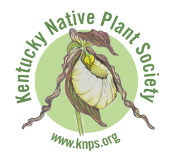by Jeff Nelson, KNPS Board Member

Get ready and be observant on these cold mornings. We are now entering the time of year when we will begin seeing one of Nature’s loveliest and most evanescent phenomenons in our region; Frost Flowers.
What are Frost Flowers?
Frost flowers are thin ribbons of ice that form on the stems of a few species of native plants. Water from the roots is drawn up the stems (either as part of the plant’s natural transportation system or through capillary action) and expands as it freezes, breaking the stem walls and creating a flow of ice. As the ice forms, more water freezes, forcing out ribbons of thin ice . Other names for these structures are “ice flowers”, “ice ribbons”, “ice fringes”, “ice filaments”, and “rabbit ice”.
Conditions Needed for Frost Flowers to Form
Frost flowers form only when certain very specific conditions all come together:
- Air temperatures must be below freezing (usually below 30°).
- There should be little to no wind.
- Ground temperatures must still be above freezing.
- There must be some degree of soil moisture.
- They only form on particular species of plants.
If conditions are right, the same plants can produce multiple frost flowers in a season, starting as early as November and producing frost flowers as late as early February. Usually the first frost flowers of the year will extend quite a ways up the stem, without extending out very far, as the entire stem splits. By the end of the season, when the stems are completely shredded, the frost flowers come out from the very base of the plant.
What Plants Produce Frost Flowers?
Worldwide, there are roughly 30 species of plants that produce frost flowers. In our region there are three native species that typically produce frost flowers. The two most common are white crownbeard, a.k.a. frostweed (Verbesina virginica) and common dittany (Cunila origanoides). A third species, that is mainly in wet areas, is marsh fleabane (Pluchea camphorata). I have heard that frost flowers sometimes appear on species of sage (Salvia) but I have never seen that and don’t know for sure what species of sage may produce frost flowers.
Grow Your Own Frost Flowers
Although it is always exciting to find frost flowers in the “wild” another option for folks is to plant one of the natives that produce this phenomena in the yard. My frostweed patch came from a single plant that volunteered in the front yard about 6 years ago. It has reseeded itself and now many others have sprouted from the seeds of the original. On cold mornings I can now just look out the front window and see the frost flowers.





















